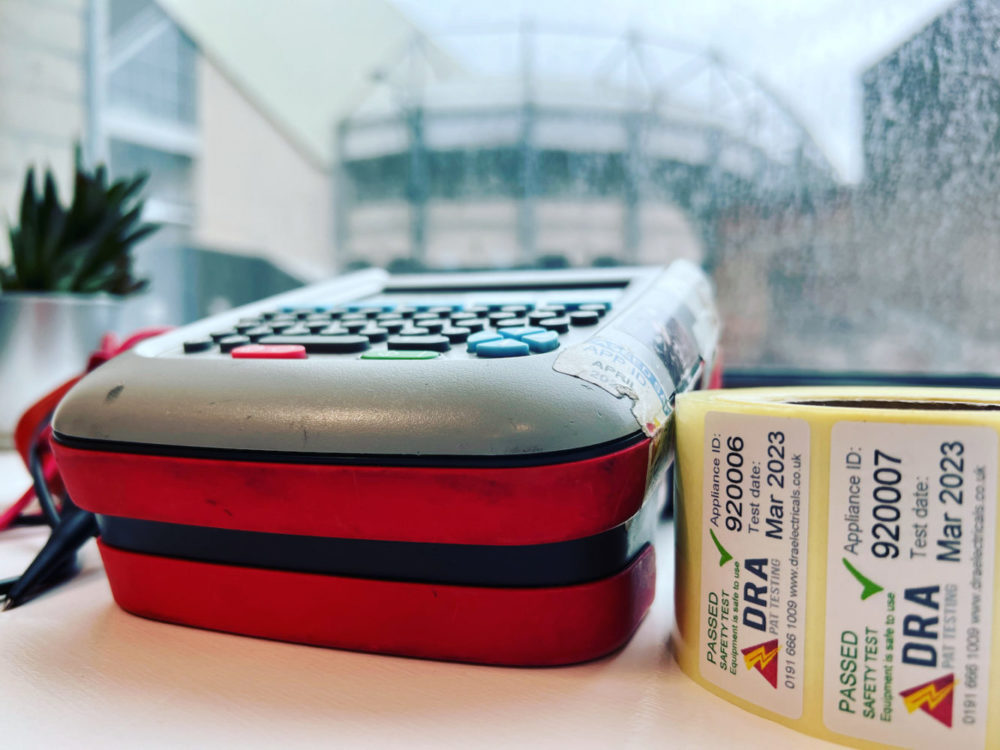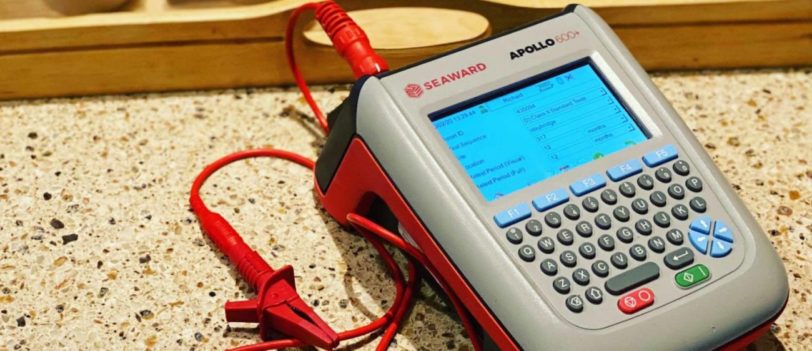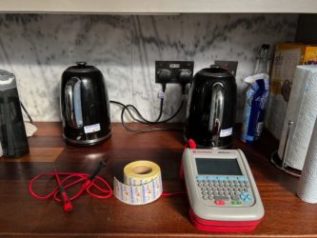Everything you need to know about a PAT Test Certificate
A PAT testing Certificate is an important document to keep in your company’s Health and Safety file; in fact it could be essential.
These days more than ever, the need to protect yourself is greatest, but also the need to protect others should be at the forefront of your mind. Electricity can be a killer if not handled correctly, and a damaged electrical appliance can very easily become a killing machine, which is why it is essential it is regularly maintained by a competent person.
If there is an accident at your workplace, caused by a faulty electrical appliance, the investigators are going to want to see evidence that you have done everything you can to ensure that the appliance was safe.
A recent PAT test report, which shows that appliance was safe within a reasonable amount of time leading up to the accident, could be a valuable document, as it could just be your ‘get out of jail free‘ card.
A report for the inspection is going to show that you did get the appliance checked to make sure that it was safe, and the check did show that the appliance was safe.
That report that we issue details everything you need including a description of the appliance, it’s location in your workplace, the tests carried out to prove it was safe and the results of the test, in the form of electrical readings. You may be surprised to learn that most PAT companies do not provide the electrical test readings obtained during the inspection, they simply tell you if the appliance passed. If there was a major investigation into the safety of your business, a simple report showing only that the appliance passed, and not how or why, may not be sufficient evidence to help you, so when you are considering a supplier make sure they are providing what you need. A good indicator of what service you’re going to get is in the price quoted – these companies charging low rates (e.g. less than around £1.20 to £1.50 per item) are cutting corners so be careful.
Our PAT testers are professionals, they’re experts in their field and when we carry out your inspections you get the peace of mind that when we say an appliance is safe, it has been properly checked and is safe. Our PAT Testing Certificates are only issued when we are sure that what we have passed is safe.
Any appliances that require repair, are repaired and those repairs are detailed on the report, and any appliance that are deemed unrepairable or too dangerous to pass, are recorded as Failed.
Having that document is going to give you evidence that you have done what was expected of you, to ensure the equipment was safe to use.
You can give yourself this peace of mind, by getting us, DRA PAT testing, in to inspect and test your electrical equipment to make sure it is safe to use, and to provide you with your very own PAT Test Certificate.
You can get a PAT test Certificate by contracting us to do your electrical equipment testing, to make sure appliances are safe to continue using. When we have done our checks and deemed the appliances to be satisfactory we will provide you with your Portable Appliance Testing Certificate.
Your PAT Test Certificate is important – be wary of scammers
Even the PAT testing industry has scammers and cowboys, so be careful who you choose. The Portable Appliance Testing Trade Association is working hard to eradicate these companies but its a slow process, and we’re still seeing many innocent people get caught out.
But what makes a scammer and how can you avoid them?
A scammer is going to charge you for one job and do another; or at least not do what you think you’re paying for. If something seems too good to be true it probably is. The best PAT testers charge around £1.50-£3 per item equivalent, and for this you usually get what you need if an accident happens – you need electrical readings on your report; a report without that will not help you in a legal battle. danglers
Anyone charging less than £1 item will need to cut corners to make even just minimum wage, so they’re not going to do everything they should in the inspection, potentially missing dangers, so consider that – why bother to pay when you still could have dangerous equipment.
We know of companies that are called ‘sticker jockeys’ and their guys simply run around your office slapping stickers on as many items as possible, in as quick a time as possible, because they have to ‘test’ 500 items a day just to make basic money. This isn’t PAT and gives the industry a bad name.
These people also are unlikely to give you a report – we see reports done by a large national UK PAT Testing company who don’t even keep a record of their work; their engineer does a hand-written report whilst on site and leaves it with you! It’s messy, hard to read and doesn’t provide the information you really need. Its sloppy work and puts you at risk.
What must a PAT Testing Certificate include?

The Certificate must have your company name and address on it; that’s essential.
- Company Name
- Company Address
These are essential – if you change address, you need to get a new inspection done. Equipment may get damaged in transit and the certificate will be invalid with the incorrect address on it.
4 things a PAT test Certificate must contain, as minimum
A PAT test Certificate is a document issued to you following completion of the PAT test.
It’s a record of what has been done. Records take all kinds of format from a hand written list to a fancy PDF document.
As a rule, there is a minimum requirement for the PAT Testing Certificate, which is, that every certificate must contain:
- The details of the site where the test has taken place
- A record of each appliance tested, and whether it passed or failed
- The date the test was done
- The details of the company or person that conducted the tests
This is an example of our PAT test Certificate records list
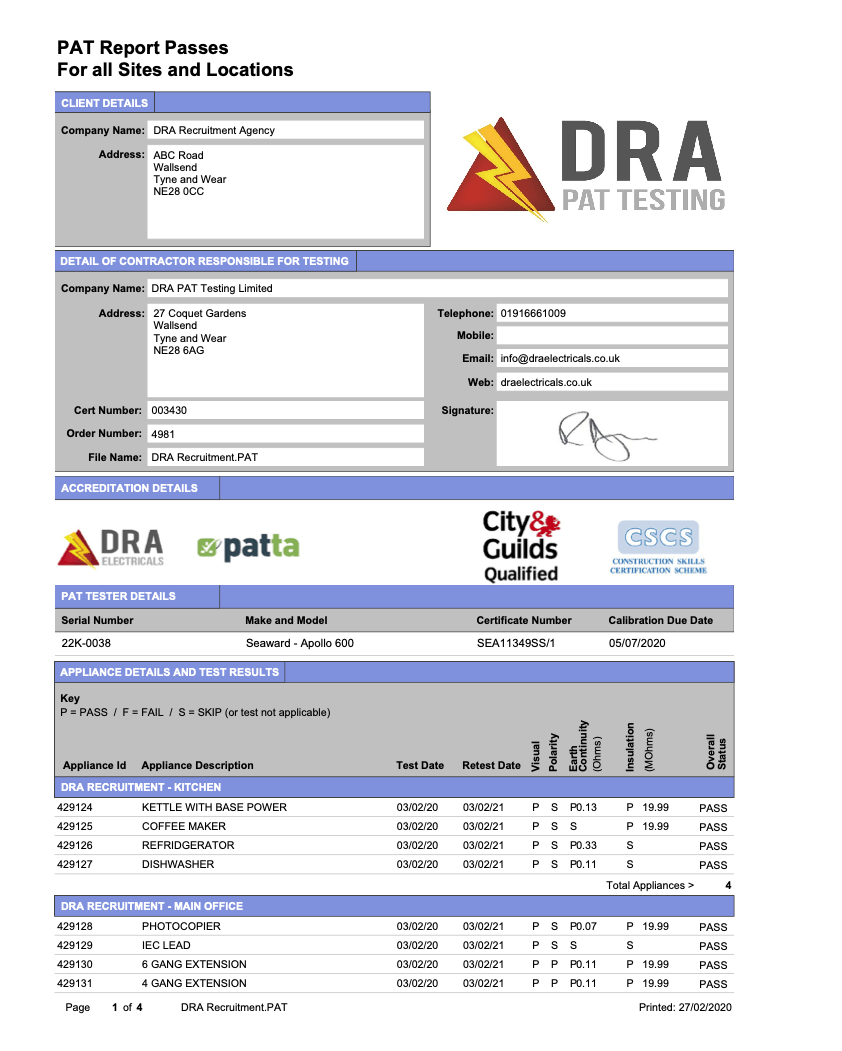
As you can see it shows the 4 things a PAT testing Certificate must have, as a minimum.
It also shows one other essential section, that few PAT companies provide, but is essential if you want to ensure you have sufficient evidence if there is ever an investigation against you.
The most important part of the PAT test Certificate that’s often skipped
Electrical Test Readings are rarely displayed on a PAT Certificate, but you need them!
We see loads of PAT testing Certificates that don’t include the number 1 section, that you need more than anything else, if you ever get investigated.
If you are up in court in a legal dispute and you need to present evidence to prove you have done all you can to ensure your electrical equipment is safe, a hand written report, or a report without electrical readings will not help!
You need the PAT Testing Certificate Report that you get to include electrical test results; if the report does not include this, how will anyone ever know what the test results where and thus what the safety situation was for the appliance when it was tested?
Having these also means the PAT tester, could even be called as an expert witness to help you case.
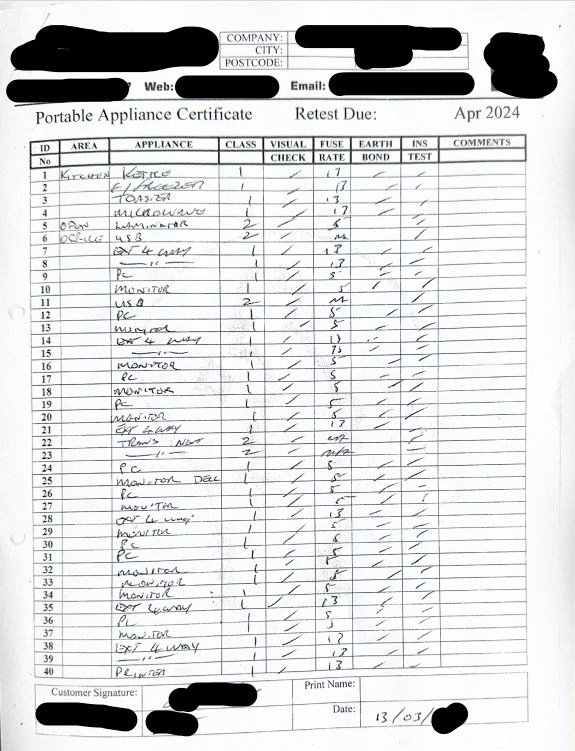
A Certificate just like this is issued by a PAT testing company, and whilst it does provide basic information you have to wonder what use it will be if something goes wrong.
- There are no test results
- It’s not clear whether the marks are ticks that the test has been done or if they have been skipped
- The fuse ratings are not clear – in fact, there is no requirement to provide this information – checking the fuse is correct is sufficient.
- Some of the descriptions are ineligible.
If the engineer leaves this original document (this is a scan of the original paper copy) is his company keeping a record too? What happens if you have a fire in the office – do you have a copy saved online?
Electrical Test Readings – possibly the most important part of a PAT Test Certificate
The PAT Test Certificate needs to include a report with electrical test readings; when you get your mains wiring inspection done the EICR includes the test readings – without it its just a sheet with ticks on; it’s the same with PAT.
This is an example of a report from us without test readings on – it’s a good report, it looks nice, but without the results of the test it’s no good to anyone.
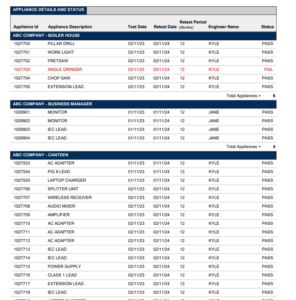
*This report is from our own software, to show as an example, a report that looks really good but still doesn’t provide the information you need.
This is an example of the PAT test Certificate we issue
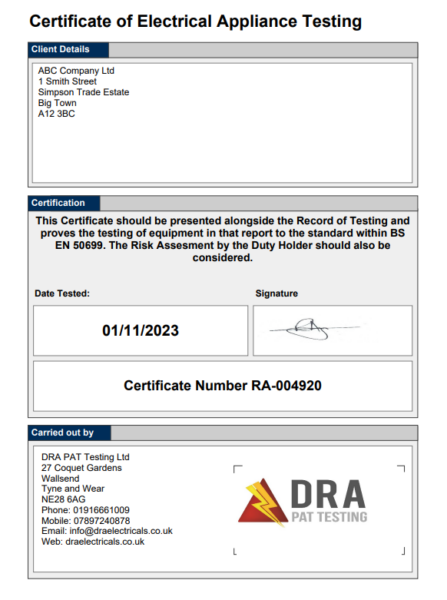
This is a great example of a PAT testing Certificate, showing what a good certificate should look like.
It shows all the useful information we should see:
- Client details: Company name and address
- Certification information, date of test, quality signature and certificate number
- Our details
Download an example of our PAT Testing Certificate
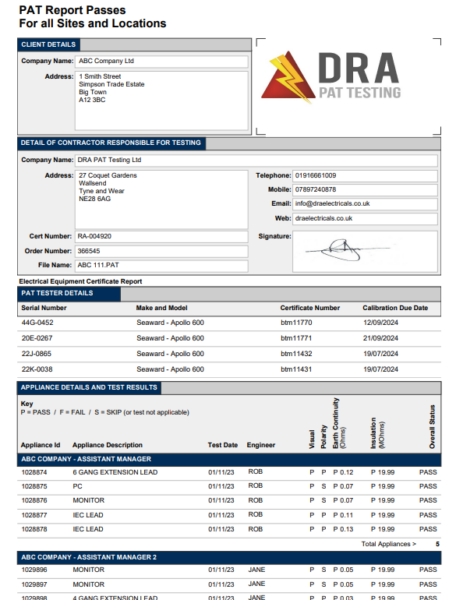
Download a full example of a PAT Testing Certificate Report like the ones we produce for our clients here:
This is an example PAT Testing Certificate report like the ones we issue. It includes all the essential information you’re going to need it to contain, to ensure your compliance.
- Your Company Name
- Your Company Address
- Our details
- Calibration email for our testers
- The locations of where appliances are
- The ID Number from the label
- The appliance description
- The test date
- The engineer’s name
- The tests carried out, indicated by the ‘P’ in the line of the appropriate test (p = pass, s = skip, f = fail)
- The test readings obtained, e.g. item 1028875 in the Assistant Manager’s office passed the Earth Continuity Test with a reading of 0.07 Ohms.
- The overall result of the test.
As an added bonus we also show the total number of items in that room, and all the rooms combined.
As you can see our reports include everything you need, they’re very easy to read, they’re presented well and they are professional.
To comply with your legal obligations for maintaining safe electrical equipment you will need to inspect and test your electrical equipment on a regular basis, which will get you a PAT testing certificate.
The PAT test certificate confirms you have had portable electrical appliances checked to make sure they are safe; the certificate acts as a record of compliance should you ever need it.
When we carry out inspections and testing of your electrical equipment, whether that is at home, work, etc we provide you with the report to reflect our results. It is a document which provides confirmation that each appliance tested is safe to use; we list every appliance, showing what it is, what ID number it has been allocated and whether it is safe or not.
If an appliance is not safe we will guide you on what measures you need to take next.
- The certificate you receive will list all the appliances tested, and their unique ID numbers (that match the labels stuck to the appliances)
- The report includes the results obtained by the tests carried out – we check each appliance is not damaged, and test those that need it to make sure they’re within the required safety range.
- We also break down the report to locations at your site, for example, a list of appliances in the office, the meeting room, the kitchen etc.
- In addition to the list of appliances tested, we provide a report on any appliances that we can’t repair; which fail overall.
- We also provide you with an overview certificate document to keep in your records which will show the test date and your address.
- We are very experienced, and the best at what we do, so we can assure you when we say your appliances are safe; they are.
Our PAT test Certificates have been scrutinised, and deemed acceptable, by Health and Safety professionals, fire officers, insurance investigators etc.
We also guide our clients on the most appropriate pat testing frequency for their equipment use, as knowing how often a PAT test is needed is good to know, because you can get it done too often, and that would be a waste of your money.
Portable appliance testing is carried out in almost every workplace in the United Kingdom, it has been getting done for many years and is very important for protecting business owners and equipment users alike, for differing reasons. A PAT test certificate confirms that a business owner has completed portable appliance testing, and serves as confirmation that the electrical appliances in the workplace, office, or home for that matter, are safe.
Portable appliance testing is carried out to reduce the chances of an accident occurring.
Although it is not a legal requirement to get portable electric appliances tested; it is a requirement to make sure they are safe to use, and as the only recognised method for checking an electrical appliance is safe is by a PAT tester it is essential you get it done.
We will provide you with your own Portable Appliance Test Certificate after we have tested your appliances.
A portable appliance is any electrical appliance that can be unplugged from a socket; all electrical appliances with a plug fall under the scope of “portable appliance testing”.
Our PAT test certificates include all the information you need to be able to show you have taken necessary action to check your equipment is safe to continue using.
Contact us to get your PAT Test Certificate
PAT Testing FAQs
If you change address you will need to get a new PAT Testing Certificate, as your current one will be invalid with the incorrect address.
You will need to arrange for a new inspection to be carried out of your equipment, in case anything has been damaged in transit too.
A portable appliance is an item that can be moved and unplugged from the mains power supply. A portable appliance includes computers, power tools, hair driers, kettles, washing machines, welding sets etc.
The PAT Testing Certificate Report we issue includes everything you need to support you should you ever find yourself under investigation.
Most providers do not supply you with electrical test results – without them, the report would not be accepted in a legal dispute.
Our reports clearly show the ID number (which matches the label), the appliance description, the location of it, the test engineers name, the tests carried out and results obtained.
Our reports further include all repairs carried out – hardly any of peers provide this, but it is essential to you as a maintenance log.
We issue PAT testing Certificate Reports within 5 days of the job being done for existing clients; or within 2 days of the payment being received for new clients.
If you need the certificate the same day, this can be arranged.
How often you need to get PAT testing done depends on numerous factors, including:
- Your own risk assessment – a risk assessment will help you determine what needs to be done to maintain safe equipment
- A fire prevention risk assessment – will assess what needs doing to prevent fires occurring
- The use of the electrical equipment and who uses it
- The working environment in which the electrical equipment is used
- The type of equipment
- What your insurance stipulates – insurance small print assumes you are meeting your Health and Safety obligations
- The Electricity at Work Regulations 1989 require that any electrical equipment that has the potential to cause injury is maintained in a safe condition. Regulations don’t state how often this needs done, or what needs doing; nor do the HSE – because they don’t want to risk being sued!
Most companies assume an annual PAT testing frequency because it is considered to be best practice.
Electrical Equipment Testing is often confused as the new name for PAT testing; it’s shocking how many companies have got this wrong. Electrical equipment testing hasn’t replaced PAT Testing; it’s always been there.
When we talk about electrical equipment, we are referring to all types of electrical equipment, whether fitted with a plug or not, and electrical equipment testing is the overview term for all inspection types that are used to ‘test’ these items to make sure they are safe. This includes PAT or Portable Appliance Testing; used to check appliances with plugs are safe, and FAT or Fixed Appliance Testing – FAT is carried out on appliances that are hard wired into the main wiring installation of a building.
PAT Testing, aka Portable appliance testing is the term we use to describe a safety check carried out on electrical equipment to make sure they are safe to use. As part of this inspection we carry out a visual examination, done by a competent engineer, who will find most defects, and repair them. When we are satisfied the appliance is safe we will carry out appropriate electrical tests to check the internal wiring etc.
PAT testing should not be confused with electrical equipment testing; they are not the same. PAT or Portable Appliance Testing is only for electrical equipment fitted with a plug.
PAT testing is a formal visual inspection and electrical testing by a competent person at appropriate intervals, dependent upon the type of equipment and the environment in which it is used, to maintain safety standards.
Why is a PAT test Certificate from us better than one from others?
If you ever get investigated for an electrical equipment accident you’re going to need evidence that your equipment is safe. If you have a PAT test Certificate that just says “pass” and tells the reader not much else, then you’re going to be in a tricky spot, because as evidence goes, it’s not very helpful.
A record from us shows you the test results obtained when the appliance was checked. These results can be used to determine how safe an appliance was. An expert eye looking at them will be able to see they were really safe when last checked, and that, is going to help you.
You see, a record that just says “pass” doesn’t tell you anything. It’s well known that ‘cowboys’ cut corners, and one of the corners they often cut, is not actually doing the test at all, then saying an appliance passed PAT testing when it didn’t actual get tested; it just got looked at. Sometimes it doesn’t even get that!
If you need a PAT test Certificate; you need your equipment testing
Arranging to have your electrical equipment tested couldn’t be simpler; all you need to do is contact us to make the arrangements. You can book your PAT testing here or contact us to discuss your situation.
Check out our main page for PAT testing Certificates which provides further information about how this certification supports that a business is complying with the Electricity at Work Regulations.
What benefits do PAT testing Certificates offer?
In order to comply with work regulations electrical equipment must maintain safety standards; to prove this has been done most people get PAT testing done. The PAT test involves a formal visual inspection by a competent person, plus, if necessary a test carried out by a portable appliance tester manchine.
After it’s been done they are sent a PAT testing Certificate. The Certificate confirms PAT has been completed and equipment that has passed is safe.
However contrary to popular belief, the certificate is not a single document saying “this certificate confirms..” but is actually a record of all appliances tested and the results obtained.
The results obtained by the tests that took place are shown next to the appliance, these include; result of the visual inspection (arguably the most important part of the test), result of the earth test carried out on appliances that require an earth for safety, result of the insulation test which is carried out on all appliances with exposed metal parts, and the result of the Polarity test which is carried out on power cords that have an earth wire (e.g. extension and IEC leads). Other Tests may be carried out that we don’t show the results for, such as if a socket tester or voltage meter has been used.
The results are more beneficial if they show the electrical readings but that isn’t necessary and some don’t provide it; sometimes a simple pass or fail is sufficient providing you know what it means. We alway provide reports with readings, unless you tell us not to.
The results are broken down into locations at your site, for example, separating the main office from the meeting room, and from the kitchens.
When a PAT certificate is issued it confirms that the client for whom the equipment has been tested is complying with the regulations by having their appliances tested, to make sure they are safe.
The certificate is evidence that the responsible person is taking steps to ensure safety of users of equipment.
The PAT Testing Certificate must show the address where the testing took place, the name and address of the company that did the testing, the date of the test and it is recommended but not essential, that an expiry date be shown. After all the results of the test are only as good as the time they are done; the tester can’t guarantee the appliance will stay in that condition until X date.
The PAT testing certificate doesn’t show the list of appliances or their results, that is for the report; the certificate is an official document that provides proof that appliances have been tested so that business owners can confirm their compliance with the regulations.
If you want to know more about what PAT testing can do for you check out our blog on the best benefits of PAT testing.
If you receive a list of appliances with no readings on then you have no clear evidence of what has been done, and the report is not complete.
We provide every client with:
- the opportunity to check the engineers work and sign off the job sheet before he leaves
- a full report and certificate, emailed as a pdf, within 5 days of the job being done
- a record of your reports kept on our servers for as long as you are a client
- recommendations on what to do with failed appliances
- recommendations for PAT testing frequencies
- an automatic booking system, for future retests, provided to you with your PAT Report, and a reminder nearer the time
The report is sent to you as one pdf document attached to an email address.
Frequently asked questions about PAT Test Certificates
What is a PAT test Certificate?
A PAT test Certificate or Portable Appliance Testing PAT Report (depending on who you ask) is a document that is issued to business owners after their electrical equipment has undergone the practice of Portable Appliance Testing PAT, otherwise referred to as PAT testing. Portable Appliance Testing is a process conducted on electrical appliances used by businesses to ensure they are safe for continued use.
Although it is recommended that we call it PAT or Portable appliance Testing we in the industry prefer to call it Inspection and Testing, but no-one knows what that means, so we simply call it PAT testing. We try to refrain from the use of the word ‘portable’ as that causes confusion and doesn’t cover everything we do.
“Portable” refers to the appliance being portable from the mains, ie it can be unplugged. It has nothing to do with whether it can be moved. However, it is not just appliances with plugs that we have to test. We also test appliances with industrial adaptors, and appliances that are wired directly into the mains supply via a fused connection unit (or spur).
Put them all together and we are completing PAT testing, after which we issue you with a completed PAT test Certificate Report.
The PAT testing Certificate provides confirmation that the company or organisation in question, is complying with the regulations by having regular inspections carried out on their portable electrical equipment.
These regular checks look for damage and other risks that need repairing or fixing in order to make the appliance and or workplace safer.
What does a PAT test certificate look like?
A PAT testing company such as us has our own PAT testing certificate template that we use to provide our clients with the certificate they need to show evidence that they are complying with the UK health and safety regulations for electrical safety.
Our Certificate is a very thorough document, much like the electricians EICR document; it includes your information and ours as standard, details of the latest calibration of the test machine that was used on the job (that is an important part missed off a lot of Certificates), and includes itemised details of all the appliances that have been tested and have passed or failed.
Our report is broken down in to locations at your site, for example, if you are running a doctors surgery the report will show all the appliances in each room, e.g. all the equipment in the reception area, everything in the admin office, everything in each doctors room, and so on.
Each item tested is assigned its own unique ID number, of which it will be the only one ever with that number in our database, for reference later; that number displays in the report and you can cross-reference it to the appropriate appliance in the room.
Some PAT Certificates show an expiry date; this is actually not a recommended procedure but can be useful as a guide for how often testing should be carried out.
The certificate is a document; we call it the PAT Testing Certificate Report to minimise confusion; the report consists of:
- The front cover
- The generic guidance document
- The PAT testing Certificate
- The itemised PAT Testing detailed report
- The itemised Fails report
- Photographs of any major fails
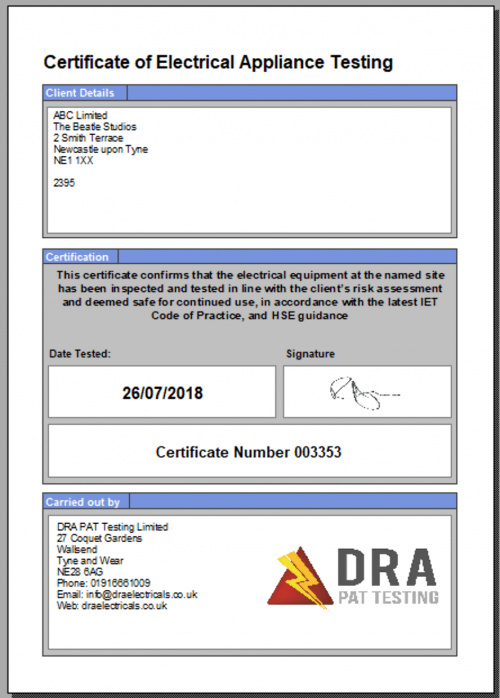
How to get a PAT test Certificate
To get a PAT testing certificate you will need us to come to your place of work, or home, depending on what the equipment is used for, for us to inspect and test your electrical appliances to confirm they are safe. When we have done our inspections we will be able to provide you with a certificate. We don’t issue the certificate before leaving your site; that is done at our office and emailed to you as a pdf report.
We get a lot of calls from people who want a PAT testing certificate, but they expect us to just send them one. That’s not possible without having first tested the appliances the certificate is for, which is what do.
So we need to arrange to visit your home or workplace to test your electrical appliances after which we will provide you with an itemised report and overall certificate. It is actually the itemised report and any guidance we can give you for improving safety that is important, not the actual certificate (which doesn’t really do much if we’re honest).
PAT testing is a serious business – inspecting and testing electrical equipment to confirm it is safe is an essential part of any health and safety policy that shouldn’t be taken lightly. We can’t just give you a certificate; we need to actually test your equipment first.
There’s a couple of images below that show good examples of our PAT testing Certificate and a part of an itemised report.
How often do I need to renew the PAT Certificate?
How often PAT is done depends on the risk assessment; whether your workplace or equipment is low, medium or high risk, etc. It could be as often as every 3 months, or as little as every 5 years.
It depends on the appliance, it’s use, the environment it is used in and other factors. Carrying out a risk assessment or getting us to guide you is the best way to determine how long a PAT test certificate lasts.
Have a look at our PAT testing frequency page which goes into a lot more detail about this topic.
How much is a PAT Test Certificate?
A PAT test certificate is issued after PAT testing is carried out; pat testing costs as little as £1.00 per item; sometimes even less than that, but sometimes more. It depends very much on the job in hand, including variants like the location and the number of appliances that need testing.
Do you get a Certificate for PAT testing?
Yes… we issue a certificate as a PDF document to every client who we do PAT testing for, no matter whether you have only one appliance or tens of thousands.
How much is a house PAT test certificate?
When we do PAT testing in rental properties for landlords we tend to charge a fixed rate for the property, depending on its size and the amount of equipment we will be expected to test, and possibly repair. The best thing to do is contact us for a price, or check out our landlords pat testing page for more information.
Can I do my own PAT test Certificate?
If you have done a suitable PAT testing training course, have the knowledge, experience, and equipment there is no reason why you can’t test your own equipment and issue yourself a certificate, although we would question the ethics of doing so and surely you’d want an independent opinion.
Also, testing your own equipment is a costly business. You need to pay for training (and take time out to do it); buy PAT tester machines, labels, tools, have the time to actually do it, buy the software to produce just one certificate a year. All in you could spend anywhere from a thousand pounds upwards – will it really be worth it?

